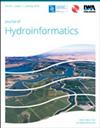输水管网水质分析中佩克莱特数阈值的定义和应用
IF 2.2
3区 工程技术
Q3 COMPUTER SCIENCE, INTERDISCIPLINARY APPLICATIONS
引用次数: 0
摘要
为了评估配水管网中的水质,我们使用了简化模型,这些模型采用了平流-反应方法,忽略了扩散-弥散现象。虽然这种简化方法在完全湍动的均匀流状态下具有足够的准确性,但文献研究表明,在层流和过渡状态下可能会产生错误的结果,而在分析低流量、环状配水管网中的死角管道或服务连接时,层流和过渡状态是非常重要的。另一方面,平动简化可在大型网络模拟中节省大量计算量。因此,需要一个标准来更好地区分哪些管道采用平动方法就足够了,哪些管道需要采用扩散方法。本研究旨在探讨如何使用佩克莱特数来区分采用二维(2D)平流-扩散方程和一维(1D)横截面平均平流-扩散方程的平流简化。使用 EPANET、一维平流-分散-反应模型和 EPANET-DD(动态-分散)模型对线性管道进行了数值分析。结果表明,在实际系统中,佩克莱特数不足以区分平流-分散过程的主导地位,因为它与管道的长度有关,与管道上发生的流态无关。本文章由计算机程序翻译,如有差异,请以英文原文为准。
Definition and application of the Péclet number threshold for water quality analysis in water distribution networks
To assess the water quality within the distribution networks, simplified models are used, which adopt an advective–reactive approach and neglect diffusion–dispersion phenomena. Although such simplifications can be sufficiently accurate in complete turbulent uniform flow regimes, literature works demonstrated that they could produce wrong results in laminar and transitional regimes that are relevant when analysing low flows, dead-end pipes in looped distribution networks or service connections. On the other hand, advective simplification allows for considerable computational savings during the simulation of large networks. Therefore, a criterion is needed for better discriminate pipes in which the advective approach is sufficient or the diffusive approach is required. The present study aims to investigate the use of the Péclet number to discriminate the use of advective simplification both adopting the two-dimensional (2D) advection–dispersion equation and the one-dimensional (1D) cross-section averaged advection–dispersion equation. The numerical analysis was applied to a linear pipeline using the EPANET, 1D advective–dispersive–reactive, and EPANET-DD (Dynamic–Dispersion) models. The results showed the inadequacy of the Péclet number in discriminating the dominance of the advective–dispersive process in real systems, as it is linked to the pipe's length, regardless of the flow regime occurring on the pipeline.
求助全文
通过发布文献求助,成功后即可免费获取论文全文。
去求助
来源期刊

Journal of Hydroinformatics
工程技术-工程:土木
CiteScore
4.80
自引率
3.70%
发文量
59
审稿时长
3 months
期刊介绍:
Journal of Hydroinformatics is a peer-reviewed journal devoted to the application of information technology in the widest sense to problems of the aquatic environment. It promotes Hydroinformatics as a cross-disciplinary field of study, combining technological, human-sociological and more general environmental interests, including an ethical perspective.
 求助内容:
求助内容: 应助结果提醒方式:
应助结果提醒方式:


